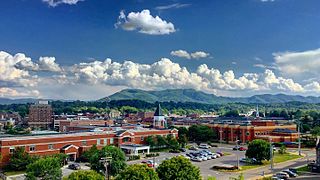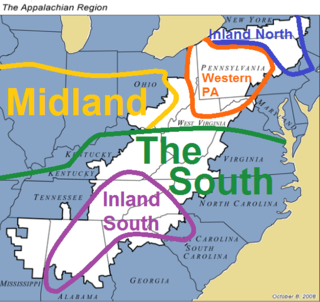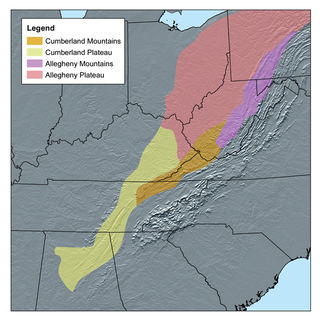
The cuisine of the Southern United States encompasses diverse food traditions of several regions, including Tidewater, Appalachian, Lowcountry, Cajun, Creole, and Floribbean cuisine. In recent history, elements of Southern cuisine have spread to other parts the United States, influencing other types of American cuisine.

Johnson City is a city in Washington, Carter, and Sullivan counties in the U.S. state of Tennessee, mostly in Washington County. As of the 2020 United States census, the population was 71,046, making it the eighth largest city in Tennessee. Johnson City is the principal city of the Johnson City Metropolitan Statistical Area, which covers Carter, Unicoi, and Washington counties and had a combined population of 200,966 as of 2013. The MSA is also a component of the Johnson City–Kingsport–Bristol, Tennessee–Virginia Combined Statistical Area – commonly known as the "Tri-Cities" region. This CSA is the fifth-largest in Tennessee with an estimated 500,530 residents.

Appalachia is a cultural region in the Eastern United States that stretches from the Southern Tier of New York State to northern Alabama and Georgia. While the Appalachian Mountains stretch from Belle Isle in Newfoundland and Labrador, Canada, to Cheaha Mountain in Alabama, Appalachia typically refers only to the cultural region of the central and southern portions of the range, from the Catskill Mountains of New York southwest to the Blue Ridge Mountains which run southwest from southern Pennsylvania to northern Georgia, and the Great Smoky Mountains of Tennessee and North Carolina. In 2019, the region was home to an estimated 25.7 million people, of which roughly 81% are white.

Appalachian English is American English native to the Appalachian mountain region of the Eastern United States. Historically, the term "Appalachian dialect" refers to a local English variety of southern Appalachia, also known as Smoky Mountain English or Southern Mountain English in American linguistics. This variety is both influential upon and influenced by the Southern U.S. regional dialect, which has become predominant in central and southern Appalachia today, while a Western Pennsylvania regional dialect has become predominant in northern Appalachia, according to the 2006 Atlas of North American English (ANAE). The ANAE identifies the "Inland South,” a dialect sub-region in which the Southern U.S. dialect's defining vowel shift is the most developed, as centering squarely in southern Appalachia: namely, the cities of Knoxville and Chattanooga, Tennessee; Birmingham, Alabama; and Asheville, North Carolina. All Appalachian English is rhotic and characterized by distinct phonology, morphology, syntax, and lexicon. It is mostly oral but its features are also sometimes represented in literary works.

The Appalachian Plateau is a series of rugged dissected plateaus located on the western side of the Appalachian Mountains. The Appalachian Mountains are a mountain range that run down the Eastern United States. The Appalachian Plateau is the northwestern part of the Appalachian Mountains, stretching from New York to Alabama. The plateau is a second level United States physiographic region, covering parts of the states of New York, Pennsylvania, Ohio, Maryland, West Virginia, Virginia, Kentucky, Tennessee, Alabama, and Georgia.

The Appalachian Regional Commission (ARC) is a United States federal–state partnership that works with the people of Appalachia to create opportunities for self-sustaining economic development and improved quality of life. Congress established ARC to bring the region into socioeconomic parity with the rest of the nation.

Appalachian music is the music of the region of Appalachia in the Eastern United States. Traditional Appalachian music is derived from various influences, including the ballads, hymns and fiddle music of the British Isles, the African music and blues of early African Americans, and to a lesser extent the music of Continental Europe.

The Upland South and Upper South are two overlapping cultural and geographic subregions in the inland part of the Southern and lower Midwestern United States. They differ from the Deep South and Atlantic coastal plain by terrain, history, economics, demographics, and settlement patterns.
The University of Tennessee Press is a university press associated with the University of Tennessee.
In the United States, the Hillbilly Highway is the out-migration of Appalachians from the Appalachian Highlands region to industrial cities in northern, midwestern, and western states, primarily in the years following World War II in search of better-paying industrial jobs and higher standards of living. Many of these migrants were formerly employed in the coal mining industry, which started to decline in 1940s. The word hillbilly refers to a negative stereotype of people from Appalachia. The term hillbilly is considered to be a modern term because it showed up in the early 1900s. The Hillbilly Highway was a parallel to the better-known Great Migration of African-Americans from the south.

Appalachian studies is the area studies field concerned with the Appalachian region of the United States.

Appalachian Voices is an American environmental organization. Their stated environmental concerns include eliminating air pollution, ending mountaintop removal, cleaning up coal ash pollution and promoting renewable energy and energy efficiency.

Appalachia is a region of the Eastern United States. Home to over 25 million people, the region includes mountainous areas of 13 states: Mississippi, Alabama, Pennsylvania, New York, Georgia, South Carolina, North Carolina, Tennessee, Virginia, Kentucky, Ohio, Maryland, as well as the entirety of West Virginia.
David Walls is an activist and academic who has made significant contributions to Appalachian studies and to the popular understanding of social movements. He is professor emeritus of sociology at Sonoma State University (SSU) in California, where he was dean of extended education from 1984 to 2000.
Settlement schools are social reform institutions established in rural Appalachia in the early 20th century with the purpose of educating mountain children and improving their isolated rural communities.
Childbirth in rural Appalachia has long been a subject of concern. Infant mortality rates are higher in Appalachia than in other parts of the United States. Additionally, poor health in utero, at birth, and in childhood can contribute to poor health throughout life. The region's low income, geographic isolation, and low levels of educational attainment reduce both access to and utilization of modern medical care. Traditional medical practices, including lay midwifery, persisted longer in Appalachia than in other U.S. regions.
Jim Wayne Miller was an American poet and educator who had a major influence on literature in the Appalachian region.
The Appalachian Regional Development Act of 1965 established the Appalachian Regional Commission (ARC), which was tasked with overseeing economic development programs in the Appalachia region, as well as the construction of the Appalachian Development Highway System. Membership included representatives from New York, Pennsylvania, Ohio, Maryland, West Virginia, Virginia, Kentucky, Tennessee, North Carolina, South Carolina, Georgia, Alabama, and Mississippi, as well as one federal appointee. This Act is one of the longest serving place-based regional development programs in the United States, and is the largest in terms of geographic scope.

Pat Gish was an American journalist, publisher and co-editor of the Whitesburg, Kentucky newspaper The Mountain Eagle, along with her husband, Tom Gish. The Gishes led The Mountain Eagle in covering controversial topics such as the effects of strip mining on the Appalachian environment and political corruption. Under the Gishes' guidance, The Mountain Eagle became a prominent rural newspaper, and the pair won many awards for their journalism. Gish also founded the Eastern Kentucky Housing Development Corporation and worked to improve living conditions in Eastern Kentucky.

The Archives of Appalachia are located on the campus of East Tennessee State University (ETSU) in Johnson City, Tennessee. Containing books, rare manuscripts, photographs, and audio and moving-image recordings, the archives serve as a resource for scholarly and creative projects dealing with life in southern Appalachia.